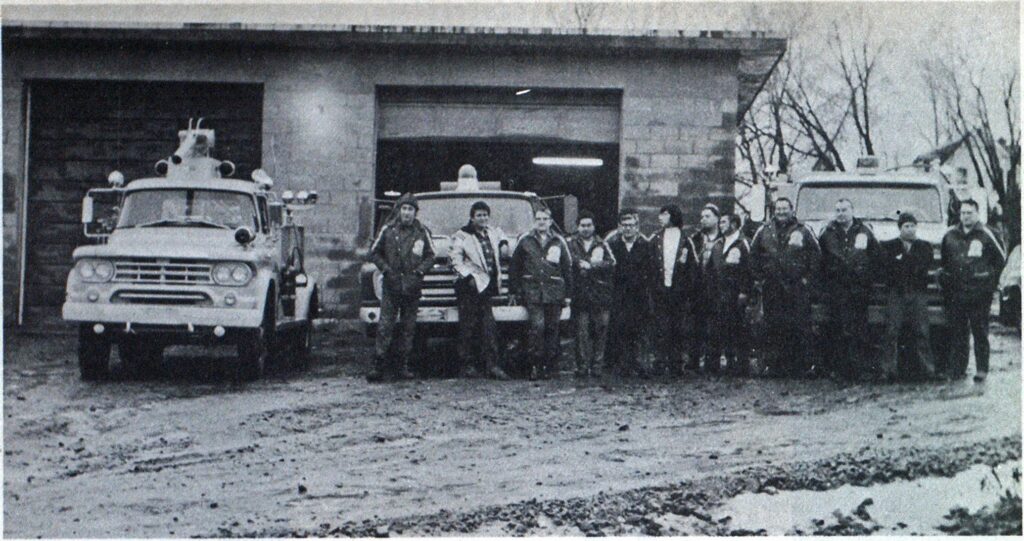
Volunteers Fight Fires in 2 Nations

The Hogansburg, N.Y., Volunteer Fire Department has an unusual distinction.
This department has firehouses on both sides of the United States-Canadian border—one in New York State, one in Ontario and one in Quebec. This unusual situation was brought about by the geography of the area, the location of the St. Regis Indian Reservation— half in Canada and half in the United States—and an independent volunteer fire department contracting fire protection to three political areas.
The department has separate fire protection contracts with the Township of Bombay, N.Y., the United States half of the St. Regis Indian Reservation in New York State, and the Canadian half of the St. Regis Indian Reservation in Ontario and Quebec.
The fire district’s 48 square miles are divided by three rivers, the St. Lawrence, St. Regis, and Raquette. This makes a wonderful water supply, but it creates the need for three fire stations to keep response time to a minimum.
Station 1 is in the hamlet of Hogansburg, N.Y., and has two engines, one tanker, a brush truck and a stationary 500-gpm tanker-filling pump. Station 2 which is on Cornwall Island, Ontario, has a tanker with extra equipment. Cornwall Island is in the St. Lawrence River, is 4 miles long, and has about 100 families living there and is connected to mainland United States and Canada by the Cornwall International Bridge. Station 3 is in Quebec, in the Snye area of the St. Regis Indian Reservation and is equipped with an an engine and a 500-gpm pump to load tankers from the St. Lawrence River. The Snye is a pieshaped piece of land approximately 6 miles long on the south bank of the St. Lawrence River. These three stations, manned by 50 volunteers, serve 7500 persons in two countries.

The department uses a telephone alarm system which feeds into a leased line to Franklin County Fire Control in Malone, N.Y. This office is manned 24 hours a day, and when there is a fire, the dispatcher activates the firehouse sirens and the 50 members’ home receivers by radio. The majority of our members are Mohawk Indians. English is always used over the apparatus radios, although Mohawk is sometimes spoken in the firehouses.
On most fire responses, men and equipment must cross the border in one direction or the other. Without the cooperation of the United States and Canadian Custom, Immigration, and Border Patrols, the crossings would cause response time delays that would make our entire operation almost impossible. Imagine a fire call that results in several mutual aid tankers crossing an international border. It happens in our area.
Hose threads standardized
We get 95 percent of our mutual aid from New York State and all our hose and fittings have national standard hose threads. This came about gradually as the department expanded to three stations, and a water system with hydrants was installed in the Village of St. Regis, Quebec. Over the years, we have become involved in such jobs as converting the threads on a used engine that came from the Canadian Armed Forces with Ontario standard threads. Without the standardization of threads, we would have had Ontario, Quebec, and national standard hose threads in our different areas. This situation could have resulted only in delayed water application.
Since our income, contracts, buildings and equipment are in two countries, the department has to have bank accounts on both sides of the border, and we have to constantly watch the United StatesCanadian rate of exchange to economize on our purchases—a purchasing problem most departments don’t have. In addition to the money brought in by the fire protection contracts, the department holds an annual field day to raise additional money for operational expenses.
Fire reports are time-consuming. Three station reports have to be combined and then reports must be sent to Canadian and United States officials. For the Canadian side, reports are sent to the Dominion Fire Commissioner in Ottawa, Ontario, and the St. Regis Band Council Office (tribal office), St. Regis, Quebec. For New York State, reports are sent to the Division of Fire Prevention and Control, Department of State, Albany, N.Y., and the County Fire Coordinator, Franklin County, N.Y. In every case, a copy is also kept on file. As you can see, a fire generates a lot of paperwork.

International training
Training comes from both sides of the border. Franklin County instructors bring us New York State standard fire courses and we attend New York State Academy of Fire Science courses at Montour Falls. We also have received training from Niagara Mohawk Power Corp., the New York State Conservation Department, and the Red Cross. On the Canadian side, the Department of Indian Affairs and Northern Development in Toronto supplies engineering services and training. First aid courses in Canada are given by St. John’s Ambulance Corps. With regular drills and schooling from both sides of the border, the results are a well-trained department.
The department started in March 1954 after seven children died when the Cree family home burned to the ground. This family tragedy is considered to be the beginning of the Hogansburg Volunteer Fire Department. It was because of this family’s loss and courage to go on that the local people started to organize a fire department.
With Edgar Reyome, who ran a grocery store, as their leader and first chief, a handful of men started with one used engine, which they parked in Reyome’s backyard. Hubert Lantry, another storekeeper, donated an old garage for a firehouse. This building had a loft that was used as a meeting room.
Thus the Hogansburg Volunteer Fire Department became a going concern.



